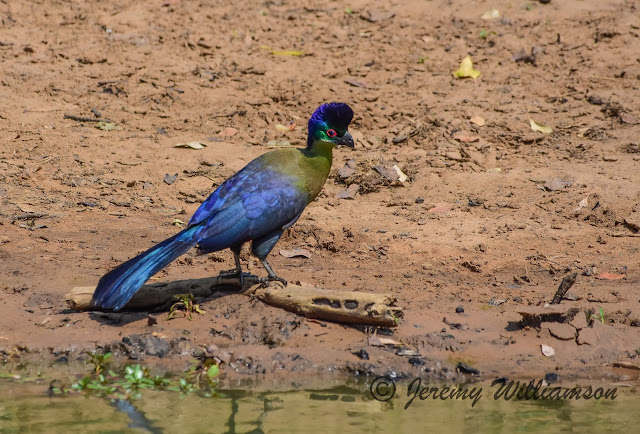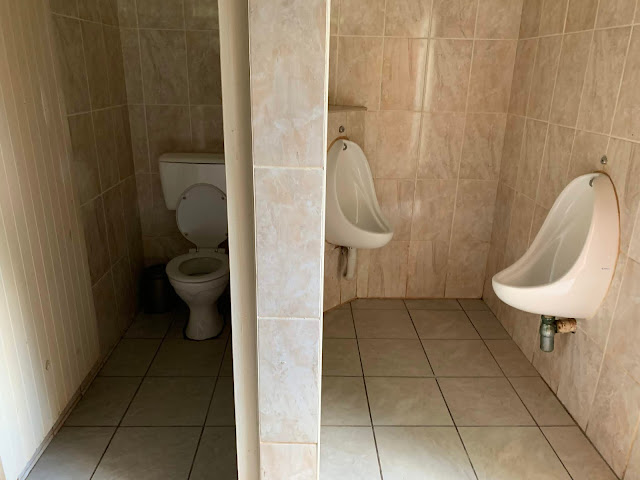The Mkuze Game Reserve in northern Zululand has been
undergoing an impressive upgrading.
Mkhuze Game Reserve is a marriage between the Isimangaliso
Wetland Park who manage the land, whilst Ezemvelo KZN Wildlife are responsible
for the management of the wildlife and the camp infrastructure.
Isimangoliso set the ball rolling with upgrading of the road
system, which included the resurfacing of the primary tarred loop and entrance
roads. This followed by the hides being reconstructed and then the two entrance
gates to the Park upgraded and rebuilt. The craft stores for the local
community that have been built at the two gates have yet to be commissioned.
The standard of this refurbishment is excellent. The three
main hides now have in the main, secure access from the car parks as well as a secure
outer enclosure with a modern chemical toilet. The path is concreted with a
smooth well-made finish, then into the gated tunnel which also has a concreted
surface suitable for wheeled access. The largest and most popular hide, KuMasinga (Masinga) has two toilets
and even a safe enclosed picnic area.
The Nsumo Pan picnic site has a relatively new flush toilet with handbasins and a concreted pathway to the water's edge. All suitable for wheelchair access.
I have reservations with regards to the distance here between the carpark and the pan, through dense riparian forest. Mkuze Game Reserve now has the 'big five' including cheetah and wild dog which could pose a security risk, with in particular children. The two hides on Nsumo Pan have shorter more open access but visitors are still vulnerable in my opinion.
The Nsumo Pan picnic site has a relatively new flush toilet with handbasins and a concreted pathway to the water's edge. All suitable for wheelchair access.
I have reservations with regards to the distance here between the carpark and the pan, through dense riparian forest. Mkuze Game Reserve now has the 'big five' including cheetah and wild dog which could pose a security risk, with in particular children. The two hides on Nsumo Pan have shorter more open access but visitors are still vulnerable in my opinion.
Mantuma has become a work in progress as from mid 2019. A
reliable thatching contractor has to date rethatched all the chalets beautifully,
on my
visit early November, they were in the throes of completing the main office
complex. The resthuts will follow being thatched after that.
After a seeming dearth of maintenance funding, the chalets
all have refurbished floors, some painted, new ¾ beds and linen,
new large Defy
fridges and plug in 3 plate stoves with ovens. New microwave ovens and our
chalet had a new kettle and toaster, this along with new utensils too.
New
mosquito screens have been installed on the doors and windows in most units, here I have concerns
that the sliding framework is too flimsy. On arrival one frame on a window in our chalet was distorted
and not able to close properly and they are brand new. They need to be slid in order to open the windows. The windows need to be closed when leaving the chalets due to possible incursion from baboons and or monkeys, so lots of sliding going on.
There is still a lot of general maintenance to be done, but
for the chalets it is more like retaining door catches and odd fittings that
have been damaged over time that need fixing. The staff seem to have a new enthusiasm
and pride in their work now that these repairs have been accomplished and they
don't have to bear the brunt of criticism for the lack of maintenance from
guest, which was in any event totally out of their hands.
The tented camp suffered extensive damage last month when a
very severe windstorm came trough, ripping tents, blowing trees over and
causing mayhem in general. Friends of mine were visiting whilst we were there,
their tent and fittings were all in good condition, theirs could be the
exception though, as Camp Management advised that the damage was fairly
extensive amongst the tents.
Our visit was primarily to see birds and secure some general
wildlife photographs from the hides. Despite there being some surface water
about from recent rains which tends to disperse the animals, Kumasinga hide was
relatively productive.
It was lovely to see Nsumo Pan full and the Mkuze River with
a bit of a flow, with the vegetation wearing its best shades of spring. Severe
fires in September had devastated large tracts of the Park which are now firmly
on the mend.
I see that since our visit on 5 – 8 November the Park has
had an additional 20 mm of rain. That should make the other two hides worth
visiting as they were virtually dry and don't have water pumped to them as does KuMasinga.
I visited eMshophi camp site at the entrance gate finding it
neat and the ablutions clean and way better than expected.
The adjacent
swimming pool was clean with a jungle gym and swings for children there. There were only few
campers on site, but all were connected to the camp electrics which the Honorary Officer
Corps had recently repaired.
Back to Mantuma and a visit to the swimming pool there.
Bright and sparkly with some residue of wind blown sand on the steps etc. Grass
cover around the pool and in general in the camp is fairly sparse.
All in all a huge improvement in facilities since our
previous visit two years ago. With the reception and office in chaos with the
thatching, their shop only had a few fridges and freezers running, just with
cooldrinks, water and ice available. I am not sure what it will be like when
back properly operational later this month. Best not to rely on stocks there.
The Rhino-dine-O was operational and did not seem to close
as per their break schedule and was open all day whilst we were there. There
were some meetings going on with a largish group, so that could have been the
reason.
The best photographic opportunities we had was from the hides.
The best photographic opportunities we had was from the hides.
I decided to exit to the east at the Ophansi gate, but
unless you are going on to Sodwana or that way I feel the road onto the N2 out
the eMshophi gate to be a lot better. Besides a badly potholed tar section from
Ophansi, then the corrugated dirt road section, once on the main tar road to
Hluhluwe, the go slow humps are very aggressive, best at 10 KPH over those and
they are numerous. I look forward to some feedback as this lovely game reserve
heads towards having acceptable accommodation, hopefully with ongoing
maintenance.
All photographs by Jeremy and Lana Williamson

































